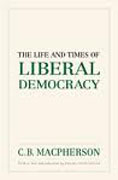
In this brief but powerful book, acclaimed political philosopher C.B. Macpherson sets out in bold relief the essence of liberal democracy, both as it is currently conceived and as it might be reimagined. The Wynford edition includesa new Introduction by Frank Cunningham. In this brief but powerful book, acclaimed political philosopher C.B. Macpherson sets out in bold relief the essence of liberal democracy, both as it is currently conceived and as it might be reimagined. Macpherson argues that from its beginnings liberal democracy has accepted the underpinning principle of capitalist societies, that the "market maketh man." If that remains the central assumption of liberal democracy, Macpherson declares, then as an organizing framework for society, liberal democracy has reached the end of its useful life. But if a broader concept of liberal democracy is accepted-"if [Macpherson writes] liberal democracy is taken to mean a society striving to ensure that all its members are equally free to realize their capabilities"-the great days of liberaldemocracy may yet lie ahead. The Wynford edition includes a new Introduction by Frank Cunningham of the University of Toronto. INDICE: Introduction to the Wynford Edition I. Models and Precursors I. Models and Precursors The Nature of the Inquiry The Nature of the Inquiry The Use of Models (i) Why Models? (ii) Why Historically Successive Models? (iii) WhyThese Models? Precursors of Liberal Democracy (i) Democracy and Class (ii) Pre-nineteenth Century Theories as Precursors II. Model 1: Protective Democracy The Break in the Democratic Tradition The Utilitarian Base Bentham's Ends of Legislation The Political Requirement James Mill's Seesaw Protective Democracy for Market Man III. Model 2: Developmental Democracy The Emergence of Model 2 Model 2A: J.S. Mill's Developmental Democracy The Taming of the Democratic Franchise Model 2B: Twentieth-Century Developmental Democracy IV. Model 3: Equilibrium Democracy The Entrepreneurial Market Analogy The Adequacy of Model 3 (i)Descriptive Adequacy (ii) Explanatory Adequacy (iii) Justificatory Adequacy The Faltering of Model 3 V. Model 4: Participatory Democracy The Rise of the Idea Is More Participation Now Possible? (i) The Problem of Size (ii) A Vicious Circle and Possible Loopholes Models of Participatory Democracy (i) Model 4A: An Abstract First Approximation (ii) Model 4B: A Second Approximation Participatory Democracy as Liberal Democracy Further Reading Index
- ISBN: 978-0-19-544780-4
- Editorial: Oxford University
- Encuadernacion: Rústica
- Páginas: 144
- Fecha Publicación: 16/02/2012
- Nº Volúmenes: 1
- Idioma: Inglés
